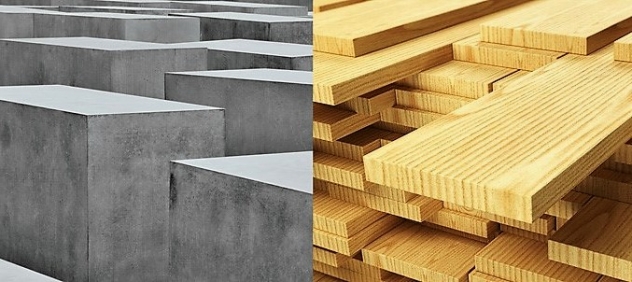THE CONSTRUCTIONIST.

SEP
25
CONCRETE VS. WOOD
5 Reasons why concrete is a better option than wood in building materials and structures
1. Durability – When it’s built with concrete it’s built to last. Concrete is a material that gains strength over time. It resists weathering, erosion, natural disasters, fire and termites. Concrete requires little to no maintenance and few repairs which adds up to solid investment. Unlike concrete, wooden frame buildings must be chemically treated to prevent damage from termites and other wood-loving insects. Wood also responds to weather effects like cold and heat, causing the wood to expand and contract. This process will alter the original wood in shape and twist, be prone to air leakage and also get moldy from dampness.
2. Safety – Concrete is safe, secure and healthy for building occupants. It is an inert material that does not burn. It does not rot or get moldy when damaged by water, which causes major health concerns and results in poor air quality in buildings today. Concrete does not give off any gas or volatile organic compounds and provides excellent indoor air quality. It prevents the entry of pollen, dust and other airborne pollutants.
3. Economical – Concrete provides one of the most efficient and cost-effective means of constructing energy- efficient structures. Operational energy requirements typically represent 85% of the total energy a building uses over its service life. A concrete building can yield life cycle savings of more than 20% of the total construction costs. Much more of the savings come from the concrete’s thermal mass, which can harvest natural energy sources such as the sun and can capture thermal energy for light fixtures and other equipment inside the building.
4. Sustainability – Builders today are more environmentally-conscious and look for durable building materials that leave the smallest environmental footprint. Produced from locally abundant materials, concrete’s long lifespan help make it the most responsible choice for a sustainable future. Recycling is present from start to finish. Many industrial byproducts that would end up in landfills are used in the cement or added to concrete mixes to provide desirable characteristics. Used concrete is recyclable and serves as aggregate in roadbeds or as granular material in new concrete. Concrete reduces the urban island effect and supports green roof projects. LEED (The Leadership in Energy and Environmental Design) certification is a Green Building Rating System – concrete can contribute over 20 points toward the minimum 26 points needed to qualify for certification.
5. Versatility – Concrete can be used in various shapes and sizes of buildings and structures. It can be shaped and molded into unique designs. Today, architectures and designers are incorporating more concrete materials in their work as it offers the flexibility they desire.
To learn more about the benefits of concrete, visit: https://www.hunker.com/12478344/concrete-block-vs-wood-construction
To learn more about LEED certification, visit: http://www.cagbc.org/FIND A LOCATION NEAR YOU
BY POSTAL CODE
KMBY CITY















